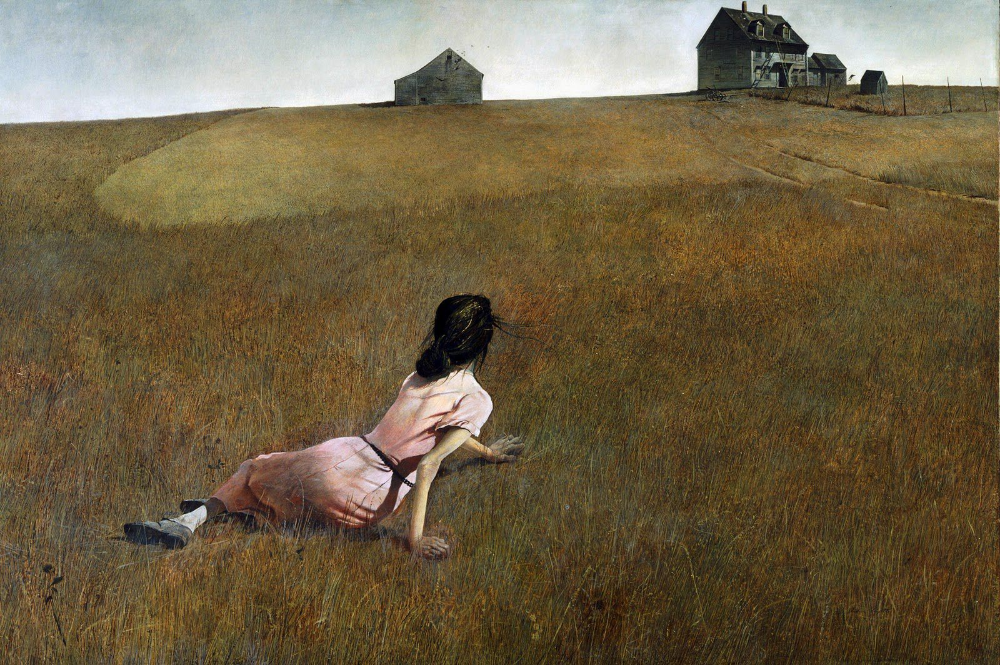Introduction
Andrew Wyeth’s painting ‘Christina’s World’ is one of the most iconic and beloved works of American art. Created in 1948, this masterpiece has captivated audiences for decades with its haunting beauty and evocative storytelling. Currently on view at the Museum of Modern Art in New York, ‘Christina’s World’ continues to draw in crowds and inspire new generations of art lovers.
A Brief History of Andrew Wyeth
Andrew Wyeth was an American artist born in Chadds Ford, Pennsylvania in 1917. He came from a family of artists, as his father, N.C. Wyeth, was a renowned illustrator. Wyeth showed a talent for art at a young age and was mentored by his father and other artists. Throughout his career, Wyeth became known for his realistic and detailed paintings of rural life in Pennsylvania and Maine.
Overview of ‘Christina’s World’
‘Christina’s World’ is a tempera painting on a 32 x 47 3/4 inch panel. The composition portrays a young woman, Christina Olson, lying in a field and gazing up at a distant farmhouse. The painting is characterized by its muted colors and the sense of isolation and longing it evokes. The scene is set in rural Maine, where Wyeth spent much of his time and drew inspiration for many of his works.
Symbolism and Interpretation
The painting has been widely interpreted as a representation of the human experience, particularly in relation to the inner world of the individual. Christina’s isolation in the vast expanse of the field and her longing gaze toward the distant farmhouse have prompted discussions about themes such as longing, perseverance, and the complexities of the human condition. The farmhouse itself has been seen as a symbol of hope and aspiration, as well as a reflection of Christina’s inner desires.
Composition and Technique
One of the most striking aspects of ‘Christina’s World’ is Wyeth’s meticulous attention to detail and his masterful use of light and shadow. The composition is carefully constructed, with the texture of the grass and the outlines of the farmhouse creating a sense of depth and atmosphere. Wyeth’s use of tempera, a technique that involves mixing pigment with a water-soluble binder, allowed him to achieve a level of precision and subtlety in his brushwork.
Impact and Legacy
‘Christina’s World’ has left an indelible mark on the art world and popular culture. The painting has been reproduced in various forms, from prints and posters to references in literature and film. Its enduring popularity is a testament to the power of Wyeth’s vision and his ability to capture the human experience in a single image. Today, ‘Christina’s World’ continues to inspire and provoke thought in audiences around the world.
Visit the Museum of Modern Art in New York
For those who wish to experience the beauty and emotion of ‘Christina’s World’ in person, a visit to the Museum of Modern Art in New York is a must. The museum’s collection includes a wide range of iconic works from the 20th and 21st centuries, and ‘Christina’s World’ holds a special place among them. Visitors can also explore other works by Andrew Wyeth and gain a deeper understanding of his artistic legacy.
Conclusion
Andrew Wyeth’s ‘Christina’s World’ is a timeless masterpiece that continues to captivate audiences with its haunting beauty and evocative storytelling. Its portrayal of longing and isolation, coupled with Wyeth’s masterful technique and attention to detail, make it a work of art that truly stands the test of time. Whether viewed in person at the Museum of Modern Art in New York or admired from afar, ‘Christina’s World’ remains a powerful and enduring symbol of the human experience.
You can review our digital products by following us on Etsy.





